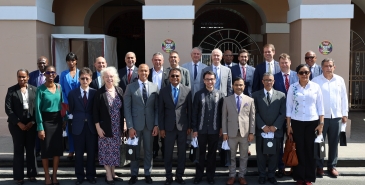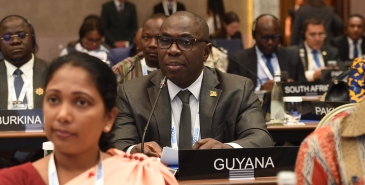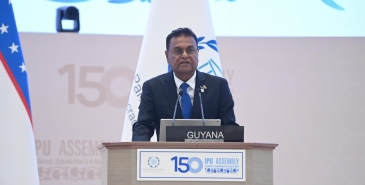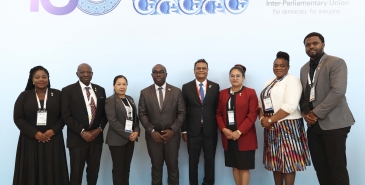Budget Speech Mrs Ferguson - 2012
Speech delivered at: 8th Sitting - Tenth Parliament - 11 April, 2012
11 April, 2012
7065
April 11, 2012
Ms. Ferguson: Before I make my presentation, I want to respond to the previous speaker. The Guyana National Service which provided opportunities for thousands of young people, Critchlow Labour College which the Government presently stifles, the Youth Corp, Guyana People’s Militia… It may serve you, Hon. Member, good stead to research before you speak.
It is with gratitude and pleasure that I take this opportunity to give God thanks and praise, my family, the people and my colleagues for the confidence they have placed in me to serve in this Tenth Parliament, which I believe is a defining moment in the legislative branch of Government.
I rise to make my presentation to this House on Budget 2012 which was presented by the Minister of Finance, Hon. Dr. Ashni Singh. My presentation, which focuses on the health sector, will address the following issues: HIV/AIDS, tuberculosis, malaria, hypertension and cholesterol which are referred to as communicable and non-communicable diseases. Persons are infected with AIDS and tuberculosis through direct contact while persons are infected with malaria through vectors, which is highly determined by the level of sanitation, while hypertension and cholesterol are commonly known as lifestyle diseases.
The Hon. Minister in his presentation stated, in paragraph 4.83, that for 2012 the Government has allocated over $ 16.9 billion to continue the modernisation of the sector and consolidate on the gains made over the past decade, as compared to the amount allocated for 2011 which was $14 billion, as stated in paragraph 4.74. In his address to this honourable House, the Minister failed to give a detailed breakdown on how moneys will be expended in the health sector, more particularly the expenditures for those critical areas to which I have already referred.
According to the National Health Sector Strategy 2008-2012, the following targets are set for the improvement of health services by 2012. Amongst those targets are reducing HIV prevalence to one per cent, tuberculosis prevalence to seventy per one hundred thousand and malaria cases to five thousand per year. My question to you, Hon. Minister of Health, is how far have we gone in achieving these targets?
The plan further stated that priority health services will be driven by the sector strategy. This will be done primarily to achieve the desired health outcomes and achieve the Millennium Development Goals (MDGs). Thus, the National Health Sector Strategy 2008-2012 will implement the 2nd Edition of the Package Of Publicly Guaranteed Health Services which priorities will be given in the following regards:
“Chronic non-communicable diseases
There will be an intensified programme to promote prevention and self care through knowledge, attitude and behaviour change, supported by health professionals, aimed at reducing hypertension leading to stroke and kidney failure and diabetes… The chronic disease programme will address the common risk factors of poor diet, physical inactivity… and seek to promote activities in other sectors that impact on these risk factors and on accidents. Health services will provide earlier detection, diagnosis, treatment and management, employing evidence based care and involving patients in their own care.”
“Communicable diseases: HIV, STIs, tuberculosis and malaria
In collaboration with Civil Society, prevention efforts will be intensified to reduce HIV, tuberculosis and malaria that remain leading causes of death and ill health in our younger populations. Treatment, care and support services will be further integrated into the health and social services offered by government and non-government providers.”
These extracts were more or less taken from the National Health Sector Strategy 2008-2012.
What the budget has failed to reflect is how the areas, as per head, will be measured. That is, how the money will be spent in keeping with programmes to be approved by this honourable House. We have heard the shadow Minister of Finance, Hon. Member Mr. Carl Greenidge, referred to the amounts proposing for spending by this Government as “slush funds” since there is no detailing in the respective areas. Specific reference can be made to Volume 3 of the Estimates of the Public Sector Current and Capital Revenue and Expenditure where there are descriptions of huge projects to be undertaken, without specificity. It should be noted with concern, that during the national population census conducted in 2002, 51.3 per cent of this country's population, between the age grouping of fifteen and forty-nine, is mostly affected by HIV/AIDS.
The National Health Sector Strategy 2008-2012 reveals an estimated number of twelve thousand persons are living with HIV/AIDS; thirty thousand persons are infected with malaria and there is a recorded figure of six thousand persons infected with tuberculosis. On the other hand, for the non-communicable diseases - hypertension and diabetes - there is an estimated figure of sixty-five thousand and forty thousand persons, respectively. Government predicts that these figures are likely to increase or remain stable in some cases. The Hon. Minister of Health should inform this Assembly of the programmes or preventative measures which are in place to treat with these communicable and non-communicable diseases since his Government would have crafted the health sector’s strategy plan.
I must confess that efforts were made to attain current data to aid in my presentation. However, I was advised that the information is classified and cannot be obtained unless the heads of the health care institutions of the various Regions approve such release.
In Region 3, where the population size is approximately one hundred thousand persons, the PPP/C received at least fifty per cent of the votes after the 2011 General and Regional Elections. Research conducted on the status of communicable and non-communicable diseases in this Region revealed that a number of persons between the ages five and six were tested. However, it was difficult to ascertain the percentage of persons tested positive and negative.
The Hon. Minister reported in his budget speech, at paragraph 4.83, lines three to five that:
“Government will continue to place emphasis on decentralising services, strengthening public-private collaboration in a continued effort to reduce chronic non-communicable diseases, improve the quality of care and access to health services, and strengthen the health system.”
This is well said but, in my view, the Hon. Member has failed to address how Government intends to deal with the communicable diseases such as HIV/AIDS, tuberculosis and malaria since these diseases are likely to increase or have already increased. I would like to know how the Government proposes to decentralise these services and how soon this will be done, since, in my view, there are areas that are being neglected and, hence, persons are forced to travel to central Georgetown to access treatment.
The Government is currently receiving aid from global health funds. In 2009, the fund accounted for around twenty per cent of international public funding for HIV/AIDS, sixty-five per cent for tuberculosis and sixty-five per cent for malaria. The Hon. Minister of Health should report whether there has been changes in the percentage figure from 2009 to current. In the current estimates before us there are no provisions for the accountability of global funds. Therefore, I would like the Hon. Minister to inform this National Assembly on how the funds are being disbursed.
Surmise to say, a physical visit was made to a number of public health institutions and the information gathered from the ground was appalling. It has been reported that systems are in place to treat with persons who are infected with these infectious diseases. However, there is need for improvement. Using these communicable diseases as classical examples, and to be specific, it has been reported that currently there are twenty- one cases of TB-infected persons who are residing at the night shelter in East La Penitence. From that figure there are five persons who are co-infected - that is, being HIV positive as well, while ten persons are coughing up sputum - that is, since having the highest stage, 4+, of tuberculosis. These persons have been tested recently. As a result of this, there is need for a surveillance system to be set up at the various port authorities. I know that in the national tuberculosis manual, mention of surveillance for TB is catered for. Therefore, how effective is this since there is gradually an increase in the cases of tuberculosis. Persons accessing health centres for medical aid reported the difficulty they are experiencing in acquiring medication for hypertension and cholesterol. Whenever supplies are exhausted and their prescriptions are referred to public hospitals they are told that they cannot get the medication there. As a consequence, they are forced to purchase the medication from a private pharmacy at a cost of $16,000 when they are only receiving a meagre pension of $7,500.
Members of staff complained bitterly of the conditions they are faced to work under. At the David Rose Health Centre in West Ruimveldt, there is a stench emanating from a septic tank situated in the school’s compound. It was reported that several reports were filed to the Ministry and to date no action has been taken. As a result of this, patients and staff constantly get unwell.
Mdm. Deputy Speaker, permit me to remind this honourable House of that fire which gutted the Lethem Hospital late last year and, hence, there is limited supply of drugs and poor services in that area. As a result of this, persons are forced to procure panadol and other painkillers from shops in Lethem. Viewing the capital expenditures for 2012, there is no provision for citizens in that area. Suffice to say, while the Hon. Member outlined in the Estimates of the Public Sector Current and Capital Revenue and Expenditure Volume 1, and I quote, page 173, under Programme 472, “Disease Control and its Objectives”:
“To ensure the effective and efficient surveillance, prevention, management and control of communicable, non-communicable and chronic diseases through intersectoral and international collaboration.”
Since there is no mention as to how this will be done, then I would like to suggest the following:
Communicable diseases: There should be continuous public education and preventative measures, rather than the Government using the period when these diseases are celebrated annually to educate its masses.
• Non-communicable diseases: There should be ongoing public education, including diets to be used.
• I trust that emphasis and priority will be placed on those persons who are currently housed at the night facility, since the housing population for displaced individuals is high and the health centre is in close proximity, hence, other persons are put at high risk.
At paragraph 4.76, page 38, the Hon. Minister, in his budget speech of 2011, mentioned that:
“Government plans to ensure testing accessibility continues to reach every citizen in an effort to achieve universal coverage for HIV prevention, diagnosis, treatment and care before 2015.”
The Hon. Member mentioned that Directly Observed Treatment Short-Course (DOTS) will be decentralised to Regions for malaria diagnosis and treatment. It is evident that in the Budget 2012 there is no mention of this initiative. A total sum of $387 million has been budgeted for training and improvement of public personnel to meet the growing demands for specialised services. As per paragraph 4.86 in the Hon. Minister's presentation, in the year 2011, a sum of $345 million was budgeted for to provide similar services as per its intended purpose for the year 2012. Information revealed that much is not being done to train the right quality of personnel. In comparing the figure from previous year, as against this year, one would question why so much was catered for 2011 and now, in 2012, a further $42 million has to be expended for training.
The information that has been provided to me is that there is poor succession planning in the nursing administration and, currently, there is shortage of trained staff to administer care and supervise students on clinical nursing. The result of this is due to the working conditions staff is made to work under which is tantamount to the remuneration they receive. The editorial of Stabroek News, Tuesday, April 3, 2012, page 6, reads, “Dr. Bheri Ramsaran and the Guyana School of Nursing”. In a synopsis, what that editorial is addressing was all of the moneys expended in training of nurses and yet the final results were astonishing, where there was an 80.5 per cent failure rate within the current batch of students.
The budgeted amount for the year 2010 showed that the sum of $300 million was supposed to be spent on human resource development in the health sector, as per paragraph 4.80, page 36. Taxpayers will become wary and want to know why in every fiscal year moneys are being allocated to train medical personnel and still there are no major improvements in the delivery of health services.
During the elections campaign, 2011, the APNU’s policies, under health services, in its manifesto are as the following:
• Significant improvement of benefits to health sector workers to enhance retention.
• Strengthen the technical capabilities of health workers at all levels through training and re-training with major emphasis on strengthening supervisory skills.
• Strengthen the procurement practices utilising objective scientific tools and increase oversight of the sufficiency and quality of the consumables.
• Strengthen health surveillance units and laboratory services in general, but more particularly in Regions where malaria is endemic, especially since the Hinterland is becoming a geographic engine of our economic growth.
Therefore I would like to suggest to the Hon. Minister of Health that he can seek to use some of the policies that the APNU has in its manifesto. The above are just a few. Since the APNU’s campaign theme was A Good Life For All Guyanese, our focus was on investing in our people to ensure quality in service is accessible in the health system, so that the ordinary citizens enjoy the benefits from the services, in contrast to what the PPP/C has proposed in its Budget 2012. It clearly shows that its centred-focus is on modernising and increasing infrastructural work in the health sector, rather than ensuring that Guyanese enjoy a good life. My question to the Hon. Member: Does that address the immediate health need of our people?
In conclusion, the figure being sought for health services where there is a huge amount being allocated for infrastructural works and purchase of equipment, I will deem unreasonable. Emphasis should be placed in other critical areas, as mentioned in the presentation, since citizens are suffering as a result of the inadequate services which are rendered to them.
I would like to implore the Government to re-look the areas for which provisions are being made and invest more in the clinical areas in the health sector. Thank you. [Applause]
Speech delivered by:
What's New

16 April, 2025
Speaker of the National Assembly Hosts Luncheon and Tour of Public Buildings for Diplomats

08 April, 2025
Minister Kwame McCoy promotes Low Carbon Development Strategy in IPU Committee Meeting on Sustainable Development

07 April, 2025
Speaker Nadir Emphasises Guyana’s Commitment to Social Development at IPU General Debate

07 April, 2025
Guyana Delegation Attends 150th Inter-Parliamentary Union Assembly in Tashkent, Uzbekistan

